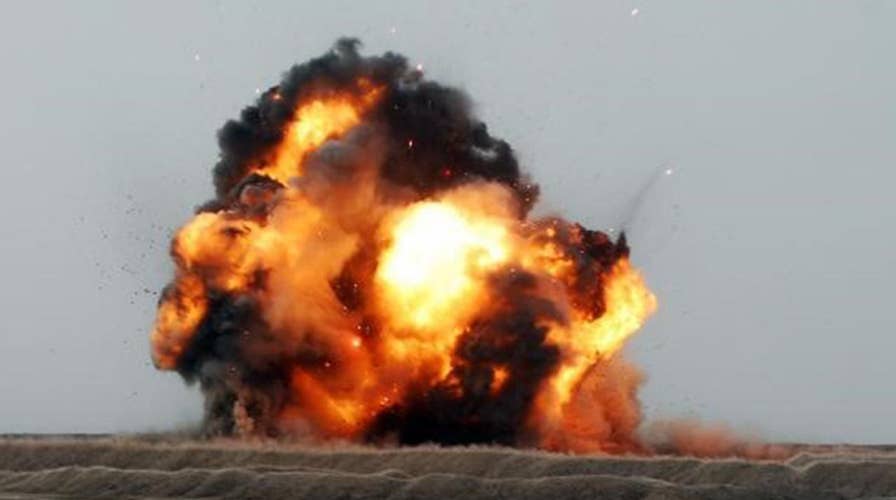Fox Firepower: Making munitions safe
Fox Firepower: Allison Barrie discusses new technology being used to create 'insensitive munitions' that will only detonate when they reach the intended target.
Our military relies on bullets and bombs to do their job — but how do we stop this ammunition from being used against our own troops?
The military needs the most powerful munitions possible, but that explosive power can put U.S. troops at risk.
Bombs, missile warheads, underwater warheads, booster rockets, rocket motors, decoys, flares, smokers, propelling charges, penetrators … all these and more can be found with American troops all over the world.
Munitions are at sea with American warfighters on aircraft carriers, in the air in helos and fighter jet, and on the ground in the battlespace and back at the base.
Whether a bomb or a missile warhead, all ammunition has been designed to be the most lethal and advanced on earth. But this means its ultra-destructive power can deliberately, or inadvertently, be unleashed against American troops as well.
WHAT IS THE NUCLEAR ARSENAL AVAILABLE TO PRESIDENT TRUMP?
The goal is for ammunition to destroy a target. However, explosive material is at risk of detonating and exploding before then. This dangerous hazard can happen in a number of ways.
How could this explosive power be turned against U.S. troops?
The enemy could deliberately target an ammo shed on a base, for example, causing it to explode. This may seem like a maneuver restricted to old fashioned cowboy movies, but that is not the case. It is a real-life threat.
In September, there was a gigantic, fiery explosion in Ukraine at a munitions depot that forced the evacuation of thousands of people from the area.
In the battlefield, a stray bullet or a piece of flying shrapnel could trigger munitions on a vehicle to detonate. A shockwave from a nearby IED could trigger detonation in some cases. Even things like heat triggers and “sympathetic reaction” explosions can occur.
Accidental explosions can also occur during the transport or storage of ammunition. Sometimes munitions can even seem to spontaneously combust when they begin “burning” — a munitions case may weaken or melt, for example. Burning is the least violent of the explosions that can occur, with debris landing within about 50 feet.
REMARKABLE SELF-HEALING TECH COULD TACKLE INVISIBLE WAR WOUNDS
Whether deliberate or accidental, these explosions can turn into very tragic incidents with loss of life and horrific wounds.
How can they be made safer while remaining as lethal as possible?
One solution to this risk to U.S. troops is something called “insensitive munitions.”
An insensitive munition only completes its intended missions. They will only destroy their targets. If it is hit by a bullet, it will not explode. If it is hit by shrapnel from a nearby explosion, it will not detonate. If it is exposed to extreme heat, it will not detonate and will only burn.
These munitions just get the job done and greatly reduce risk to U.S. troops.
There are different methods for making munitions “insensitive.” There are special transport containers and cases, for example. Another approach relies on the specific way that the munitions are formulated.
Innovation to protect U.S. troops
Orbital ATK has had a number of successes in the development of ammunition that is chemically stable enough to withstand fire, bullets, mechanical shocks and flying shrapnel without exploding — but still explode to destroy their targets as intended.
FUTURISTIC BIONIC ARMS NOW AVAILABLE FOR THE NATION’S BRAVEST
In fact, their work on the military’s iconic Hellfire missile is one of these remarkable successes. They’ve made them far safer for our troops while maintaining their famous destructive power against threats.
Orbital ATK’s work on the tactical missiles has been extensively tested against possible ignitors.
When a bullet hit, there was no reaction at all. When shrapnel fragments struck at high and low velocities, there was no reaction — as in, there was no explosion.
When challenged with slow “cook-off” and fast “cook-off,” the response was reduced to a burn — that least violent response.
They’re also developing insensitive munition rocket motors for the RAM (Rolling Airframe Missile) Block II, the JAGMs (Joint Air-to-Ground Missiles) and other tactical missiles.
What is the scale of the risk?
The loss of one American life is unacceptable. Whether inadvertent or deliberate, the results can be devastating.
NORTH KOREA: WILL MINI NUKES BECOME AN OPTION FOR TRUMP?
These explosions can greatly damage ships, vehicles, aircraft, base infrastructure and more – with the knock-on effect of reducing their readiness to fight or even taking them entirely out of the fight. And the cost of damage and destruction to military assets can be astronomical.
PODCAST: THE TRUTH ABOUT MILITARY DRONES REVEALED BY THIS INTELLIGENCE INSIDER
Stopping future USS Forrestals
Inadvertent munitions explosions can result in simply devastating fire and blast with irreversible tragic consequences. These accidents have tragically occurred in the past.
The USS Forrestal is one of the most well known. In the 1967 incident, an aircraft accidentally fired a ZUNI rocket while on the deck of the aircraft carrier. The rocket struck another aircraft and this ignited a fuel fire, which triggered a bomb to detonate. Nearly all of the firefighters were killed or seriously wounded.
The explosion also ripped open the flight deck. Fiery fuel powered into the floors of the ship and this triggered munitions aboard to detonate.
Bombs, missile warheads and rocket motors were triggered and unleashed all that immense, destructive, explosive power against American sailors. Some 134 were killed in this incident and over 100 were wounded. In addition, 21 aircraft were destroyed by the munitions explosions.
Insensitivity matters
Munitions are an unavoidable necessity.
The enhanced safety means that more missiles can be stored and transported in smaller containers — and an opportunity for significant cost savings for the government.
But more importantly, insensitive munitions innovation to better protect U.S. troops from the associated risks, like the advances made by Orbital ATK, is absolutely vital.





















